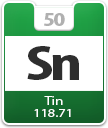Atomic Number of Tin

Atomic Number of Tin is 50.
Chemical symbol for Tin is Sn. Number of protons in Tin is 50. Atomic weight of Tin is 118.71 u or g/mol. Melting point of Tin is 232 °C and its the boiling point is 2270 °C.
» Boiling Point » Melting Point » Abundant » State at STP » Discovery YearAbout Tin
Tin is a post-transition metal which is soft and changes its form at as low as 13 degrees. Its name comes from an Anglo-Saxon word meaning stannum. It can be found in the area known as “tin belt” and also can be mined from a number of ores and minerals occur naturally. Tin is often used in alloys with other elements like copper, lead, zinc, and others, forming stronger and more convenient compounds. By adding tin to steel it is possible to make it less corrosion resistant. This element is extensively used for plating as it easily bonds with iron. Tin is used for soldering and producing superconductive magnets, for producing cans and producing glass, as well as a compound of paintings and dyes for boats, ships, and other water transportation means. Tin should be used with precautions since it is quite easy to get poisoned by this chemical element.
Properties of Tin Element
| Atomic Number (Z) | 50 |
|---|---|
| Atomic Symbol | Sn |
| Group | 14 |
| Period | 5 |
| Atomic Weight | 118.71 u |
| Density | 7.287 g/cm3 |
| Melting Point (K) | 505.08 K |
| Melting Point (℃) | 232 °C |
| Boiling Point (K) | 2875 K |
| Boiling Point (℃) | 2270 °C |
| Heat Capacity | 0.228 J/g · K |
| Abundance | 2.3 mg/kg |
| State at STP | Solid |
| Occurrence | Primordial |
| Description | Metal |
| Electronegativity (Pauling) χ | 1.96 |
| Ionization Energy (eV) | 7.3439 |
| Atomic Radius | 145pm |
| Covalent Radius | 141pm |
| Van der Waals Radius | 217 |
| Valence Electrons | 4 |
| Year of Discovery | prehistoric |
| Discoverer | unknown |